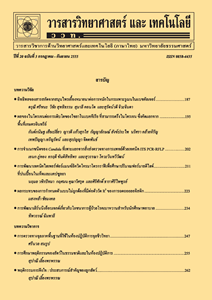Hybrid of Neural Network and Markov Chain Method for Predicting PM2.5 Concentrations
Main Article Content
Abstract
The objective of the research was to study the prediction of particles less than 2.5 micrometers in diameter (PM2.5) by using neural network and the hybrid of neural network and Markov chain model based on hourly data at the South Phra Nakhon Power Plant Station, Bang Prong sub-district, Muang district, Samut Prakan province from October 1, 2020, to November 11, 2020. A total of 984 observations were secondary data collected by the Pollution Control Department, Ministry of Natural Resources and Environment. In this research, prediction values from back-propagation neural network were classified by using Markov chain to adjust the prediction value of PM2.5 concentrations. The results showed that the root mean square error (RMSE) and mean absolute percent error (MAPE) of the hybrid of neural network and Markov chain model were 1.1890 and 3.2972, respectively. Simultaneously, the RMSE and MAPE using back-propagation neural network were equal to 2.4864 and 7.2877 respectively. It can be said that the hybrid of Markov chain and back-propagation in multilayer perceptron neural networks performs the higher forecasting accuracy than the back-propagation in multilayer perceptron neural networks.
Article Details
References
Pollution Control Department, Air Quality Index Data, Available Source: http://air4thai.pcd.go.th/webV2/history, October 1, 2020. (in Thai)
Inkhumhaeng, A., 2020, Creating the situations report of environmental health literacy on preventing the health impacts from dust particulate matter of less than 2.5 micrometers (PM2.5) of village health volunteers in ecological industrial urban areas, Research Report, Srinakharinwirot University, Bangkok, 137 p. (in Thai)
Asadollahfardi, G., Zangooei, H. and Aria, S.H., 2016, Predicting PM2.5 concentrations using artificial neural networks and Markov chain, a case study Karaj city, Asian J. Atmospheric Environ. 10(2): 67-79.
Tongboonnak, K., 2018, Forecast of dust particles up to 10 microns (PM10), National Research Council of Thailand (NRCT), Research Report, Chiang Mai Rajaphat University, Chiang Mai, 36 p. (in Thai)
Kurt, A., Gulbagci, B., Karaca, F. and Alagha, O., 2008, An online air pollution forecasting system using neural networks, Env. Int. 34(2008): 592-598.
Muhammad, M., Shafiullah, S.M., Abu, N., Abduljamiu, A. and Hasan, Z., 2020, Soft computing applications in air quality modeling: Past, present and future, Sustain. J. 12(4045): 1-33.
Zakaria, N.N, Othman, M., Sokkalingam, R., Daud, H., Abdullah, L. and Kadir, E.A, 2019, Markov chain model development for forecasting air pollution index of Miri, Sarawak, Sustain. J. 11(19): 1-11.
Lamkamol, C., 2016, Book review competency based 70: 20: 10 learning model, Business Rev. 8(2): 219-221. (in Thai)
Patrick, H.W., 1997, Artificial Intelligence, pp. 443-469, In Boonchote, K. (Ed.), Thai Keyphrases Extraction Using Artificial Neural Network, Department of Information Technology, Prince of Songkla University, Songkhla, 284 p. (in Thai)
Box, G.E.P., G.M. Jenkins and G.C. Reinsel, 1994, Time Series Analysis Forecasting and Control, 3rd Ed., Prentice Hall, Inc., Hoboken, NJ, 598 p.
Grabusts, P. and Zorins, A., 2015, The influence of hidden neurons factor on neural network training quality assurance, Int. Sci. 3: 76-81.
Dai, Y., Han, D. and Dai, W., 2014, Modeling and computing of stock index forecasting based on neural network and Markov chain, Hindawi. J. 2014(1): 1-9.


